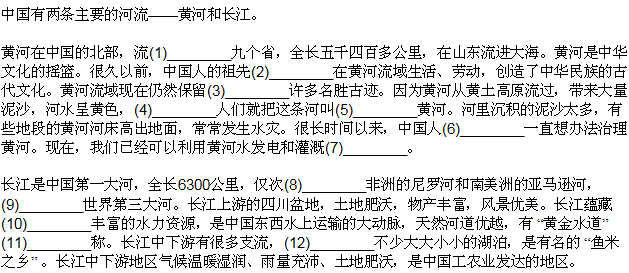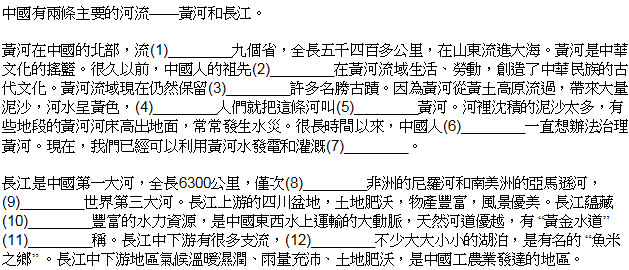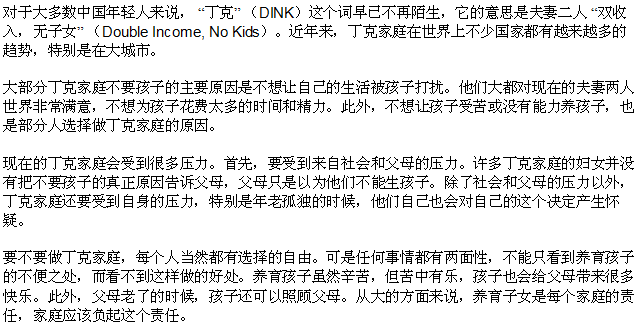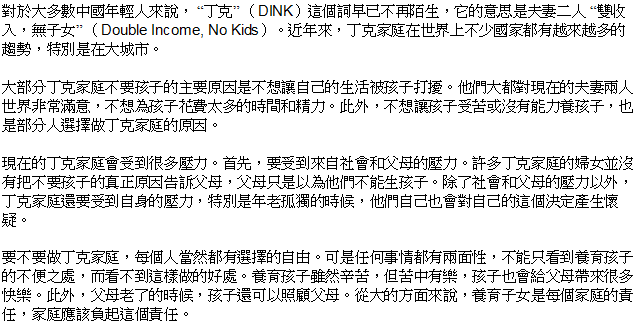Study Guide
Field 054: World Languages—Chinese (Mandarin)
Sample Language Structures and Reading Assignments
The following materials contain:
- Test directions for the language structures assignment
- A sample language structures assignment
- Sample strong responses to the language structures assignment
- Performance characteristics and scoring scale for the language structures assignment
- Test directions for the reading assignment
- A sample reading assignment
- A sample strong response to the reading assignment
- Performance characteristics and scoring scale for the reading assignment
Directions for the Language Structures Assignment
This section of the test requires you to demonstrate your command of the structures and usage of the target language. Directions are provided before each part. Your responses will be scored on the basis of grammatical correctness and sociolinguistic appropriateness.
Your final response must be written on the Response Sheets provided and scanned using the scanner provided at your workstation.
Instructions for scanning your response sheets are available by clicking the "Scanning Help" button at the top of the screen.
Your responses to the language structures exercise will be evaluated on the basis of the following criteria:
- Grammar: Part A (1–12): Supplying the grammatically correct item
- Transformation: Part B (13–16): Making a specified transformation
- Correction: Part C (17–20): Correcting errors
Sample Language Structures Assignment
Follow the directions for each of the three parts (Parts A, B, and C) below. Respond to either the version presented in Simplified characters OR the version presented in Traditional characters. Do NOT respond to both versions.
Objective 0001
Language Structures (Standard 2)
[Simplified Characters]
Part A (1–12)
Complete the passage below by providing for each numbered space in the passage the word(s) that are grammatically correct and appropriate in the context. Write each response to Part A on your answer document on the line that corresponds to the numbered space in the passage.
- Sample Response
-

Part B (13–16)
Rewrite the sentence(s) in each item below, transforming them according to the directions. Write each response to Part B on your answer document on the lines that correspond to the item number.
(13) Rewrite the sentence below using the appropriate comparison word.
- Sample Response
-

(14) Rewrite the sentence below in the passive voice.
- Sample Response
-

(15) Combine the sentences below into a single sentence that retains the original meaning.
- Sample Response
-

(16) Rewrite the sentence below using the yue construction 
- Sample Response
-

Part C (17–20)
Rewrite the sentence(s) in each item below, correcting all errors and retaining the original meaning. Write each response to Part C on your answer document on the lines that correspond to the item number.
- Sample Response
-

[Traditional Characters]
Part A (1–12)
Complete the passage below by providing for each numbered space in the passage the word(s) that are grammatically correct and appropriate in the context. Write each response to Part A on your answer document on the line that corresponds to the numbered space in the passage.
- Sample Response
-

Part B (13–16)
Rewrite the sentence(s) in each item below, transforming them according to the directions. Write each response to Part B on your answer document on the lines that correspond to the item number.
(13) Rewrite the sentence below using the appropriate comparison word.
- Sample Response
-

(14) Rewrite the sentence below in the passive voice.
- Sample Response
-

(15) Combine the sentences below into a single sentence that retains the original meaning.
- Sample Response
-

(16) Rewrite the sentence below using the yue construction 
- Sample Response
-

Part C (17–20)
Rewrite the sentence(s) in each item below, correcting all errors and retaining the original meaning. Write each response to Part C on your answer document on the lines that correspond to the item number.
- Sample Response
-

Performance Characteristics for the Language Structures Assignment
The following characteristics guide the scoring of responses to the language structures assignment.
| Grammar | Part A (1–12): Supplying the grammatically correct term |
|---|---|
| Transformation | Part B (13–16): Making a specified transformation |
| Correction | Part C (17–20): Correcting errors |
Scoring Scale for the Language Structures Assignment
Scores will be assigned to each response to the language structures assignment according to the following scoring scale.
| Score Point | Score Point Description |
|---|---|
| 4 | 17–20 correct responses |
| 3 | 13–16 correct responses |
| 2 | 9–12 correct responses |
| 1 | 0–8 correct responses |
| U | The response is illegible or not written in the required language. |
| B | There is no response to the assignment. |
Directions for the Reading Assignment
This section of the test consists of an interpretive reading assignment. You will read a passage in the target language and respond in writing to the assignment that follows the passage. Your response may be written in either English or the target language. This should be your original work, written in your own words, and not copied or paraphrased from some other work.
Your final response must be written on the Response Sheets provided and scanned using the scanner provided at your workstation.
Instructions for scanning your response sheets are available by clicking the "Scanning Help" button at the top of the screen.
Your response to the interpretive reading assignment will be evaluated on the basis of the following criteria:
- Literal Comprehension: Accuracy and completeness in comprehending the literal content of written language
- Inference: Ability to infer information implied in written language
Any time spent responding to the assignment, including scanning the response sheets, is part of your testing time. Monitor your time carefully. When your testing time expires, a pop-up message will appear on-screen indicating the conclusion of your test session. Only response sheets that are scanned before you end your test or before time has expired will be scored. Any response sheet that is not scanned before testing ends will NOT be scored.
Sample Reading Assignment
Objective 0003
Interpretive Communication Skills (Standard 3)
Read the passage presented below in either Simplified or Traditional characters. Then complete the exercise that follows. Your response may be written in either Chinese (Simplified or Traditional characters) or English. Choice of language will not affect your score.
[Simplified]
[Traditional]
Write a response of approximately 100–200 words in English or 50–80 characters in Chinese (Simplified or Traditional characters) in which you:
- summarize the main idea of the passage; and
- explain the pressures on couples described in the passage.
Sample Strong Response to the Reading Assignment
The main idea of this passage centers around the increasing familiarity of a term describing couples who both work and decide not to have children: DINK (Double Income No Kids). Not only is the term increasingly familiar, it describes a trend increasing in many countries, especially in larger cities. Couples who make a conscious decision not to have children are typically satisfied with their current lives and do not wish to have children for various reasons. Some couples do not want to complicate their current lives while others may feel they do not have the time or ability to raise children. This trend goes against traditions in which both communities and families expect young couples to have children and these expectations put pressure on couples. The passage ends by encouraging the reader to consider both sides of the issue by pointing out that while raising children can be difficult, couples who do not have children lose out on the joy and happiness that children can bring their families.
Performance Characteristics for the Reading Assignment
The following characteristics guide the scoring of responses to the reading assignment.
| Literal Comprehension | Accuracy and completeness in comprehending the literal content of written language |
|---|---|
| Inference | Ability to infer information implied in written language |
Scoring Scale for the Reading Assignment
Scores will be assigned to each response to the reading assignment according to the following scoring scale.
| Score Point | Score Point Description |
|---|---|
| 4 |
The "4" response demonstrates a strong level of skill in interpretive reading.
|
| 3 | The "3" response demonstrates a general level of skill in interpretive reading.
|
| 2 | The "2" response demonstrates a limited level of skill in interpretive reading.
|
| 1 | The "1" response demonstrates a weak level of skill in interpretive reading.
|
| U | The response is unrelated to the assigned topic, illegible, not written in the required language, not of sufficient length to score, or merely a repetition of the assignment. |
| B | There is no response to the assignment. |














